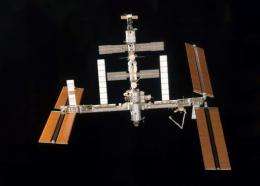Private industry in space a risky, slow business: experts

NASA's plan for the private sector to build spacecraft to fly astronauts to the International Space Station is a high-risk undertaking that won't show results for years, experts said.
The abrupt shift "harnesses our nation's entrepreneurial energies, and will create thousands of new jobs," the White House Office of Science and Technology Policy said in a statement issued as the budget for the fiscal year that begins October 1 was unveiled Monday.
It also reflects a key recommendation made by the high-level Augustine Commission, which President Barack Obama set up last year to review US human space flight plans and come up with a successor to the space shuttle, which winds down in late 2010 after nearly 30 years of service.
The US space agency's plan to turn manned space flight over to private enterprise was met with a less-than-enthusiastic reception in some quarters.
Obama has "accepted the move to put our human access to space on a commercial footing, with great uncertainty as to safety, schedule and cost," wrote four-time space shuttle astronaut Tom Jones in the magazine Popular Mechanics.
John Logsdon, former head of the Space Policy Institute at George Washington University, said critics of the new policy were "mainly concerned about safety."
Similar concerns about commercially built space vehicles figured high up in a report issued last month by the Aerospace Safety Advisory Panel (ASAP).
"No manufacturer of commercial orbital transportation services is currently qualified for human-rating requirements, despite some claims and beliefs to the contrary," ASAP's panel of independent experts said.
The annual report also warned it would be "unwise" to drop NASA's Ares 1 rocket, part of the costly Constellation project that was effectively killed by the budget plans, and hand over the ferrying of astronauts to the ISS to private industry.
ASAP was set up by Congress in 1967 after a flash fire ripped through a command module during a launch pad test of the Apollo/Saturn space vehicle, killing three astronauts on board.
Elon Musk, chief executive of SpaceX, one of the new generation of privately-owned companies with an eye on space, ripped into the ASAP report as "random speculation."
"If they are to say such things, then they ought to say it on the basis of data, not on random speculation," Musk, whose eight-year-old company has built and tested a launcher, said in an interview with Spaceflight Now.
Charles Precourt, former chief of NASA's astronaut corps and now an executive at aerospace and defense firm Alliant Techsystems, said in The Wall Street Journal that farming out large portions of the manned space program to private firms would be an "extremely high risk" path.
Putting all of NASA's spacecraft-building eggs in the basket of private industry was foolhardy, former astronaut Tom Jones said.
"Betting our nation's sole access to space on industry's ability to replicate 50 years of NASA experience on the fly is unwise. NASA should fly a new crewed spacecraft as quickly as possible, then move to commercial firms once they have a proven record of reliable cargo services," he wrote.
SpaceX already has a launcher, a capsule and a demonstration cargo contract with NASA.
Musk said SpaceX could be ready to ferry astronauts into space within three years of landing a human transport contract with NASA -- at a rate of about 20 million dollars per seat, less than half the 50 million that Russia currently charges NASA for seats on its Soyuz spacecraft.
SpaceX and other upstarts would be up against industry giants Boeing and Lockheed Martin, which together operate United Launch Alliance (ULA), whose stable includes Atlas V and Delta 4 rockets that have logged considerable flight hours.
ULA was awarded 6.7 million dollars on Monday to develop an Emergency Detection System, an element necessary for "a safe and highly reliable human-rated launch vehicle."
Logsdon said it was "very likely" that either ULA or one of its parent companies would earn a transport contract, and that the winning proposal would envision a flight-ready craft before 2016, the readiness date for the private sector put forward by the Augustine committee.
But he cautioned the date was too ambitious, and that the craft would have to be brought up to human-rated safety standards before they can carry astronauts into space.
(c) 2010 AFP

















